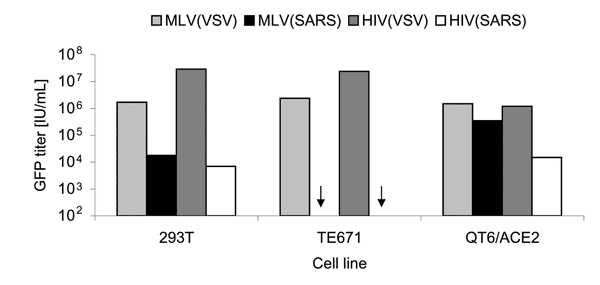Volume 11, Number 3—March 2005
Research
Longitudinally Profiling Neutralizing Antibody Response to SARS Coronavirus with Pseudotypes
Figure 1

Figure 1. . Infectivity of retroviral severe acute respiratory syndrome–associated coronavirus (SARS-CoV) spike protein (S) pseudotypes on target cells. SARS-CoV S-mediated infection of human 293T, TE671, and Quail QT6/ACE2 was assessed. Murine leukemia virus (MLV) or HIV pseudotypes bearing either the pantropic vesicular stomatitis virus envelope protein (VSV-G) as a positive control, or the SARS-CoV S, were added to target cells. After 72 h, green fluorescent protein (GFP)–positive cells were counted by fluorescence-activated cell sorter analysis. Infection titers are given as infectious units per milliliter (IU/mL). Arrow indicates that infection titer was less than the detection limit, 102 IU/mL.
Page created: April 25, 2012
Page updated: April 25, 2012
Page reviewed: April 25, 2012
The conclusions, findings, and opinions expressed by authors contributing to this journal do not necessarily reflect the official position of the U.S. Department of Health and Human Services, the Public Health Service, the Centers for Disease Control and Prevention, or the authors' affiliated institutions. Use of trade names is for identification only and does not imply endorsement by any of the groups named above.